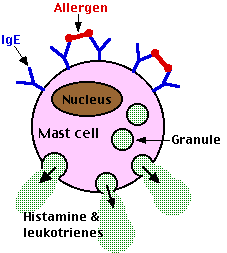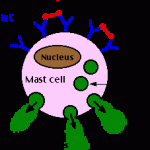Skin-prick testing is suggested in preference to in vitro-specific IgE antibody assays
Third, in individuals suspected of OA due to sensitizers, the expert panel suggests immunologic testing to identify sensitization to specific workplace allergens, when reliable and feasible, because a negative skin-prick test result with a validated occupational protein allergen test reagent has high negative predictive value. Skin-prick testing is suggested in preference to in vitro-specific IgE antibody assays. However, with the exception of a few, such as natural rubber latex and cat dander, standardized commercial skin test reagents for many occupational proteins are not available. The consensus document thereby underscores the great need to develop validated and standardized occupational allergens for skin testing. 
Fourth, there are different methods of objective confirmation of work relationship, including serial monitoring of peak expiratory flow or nonspecific bronchial hyperresponsiveness during a period at work, and a period off work as well as specific inhalation or workplace challenge testing. Since every test has potential false-positive and false-negative responses as outlined in the document, there are benefits of using multiple tests or repeating the same test.
In addition to the usual management of asthma using pharmacologic agents, the expert panel includes two other important considerations in the management of WRA. First, on the individual level, given the adverse employment and economic consequence of a diagnosis of OA, the practitioner should assist the patient to obtain compensation. Secondly, on the public health level, an individual diagnosis of OA represents a potential sentinel health event, and so his/her workplace should be evaluated to identify and prevent other cases of OA in the same setting. The expert panel, based on recent literature, also advises medical surveillance programs for secondary prevention, including questionnaire and spirometry and immunologic tests, where available, to identify individuals with preclinical disease or sensitization and remove them from further exposure.
When “The Worst” Happens
WHEN “THE WORST” HAPPENS
Being let go at work reminded Linda of her need to move forward in her life, to release the past and the good girl image — to stop holding back her emotions and her breath. She used this experience as a wake-up call to:
- Reverse her habit of procrastination
- Accept change more easily
- Seize the present moment for taking action (instead of dwelling in the past)
Linda used the FUN program to Focus, Undo, and Now Act and was able to perceive this event differently. She Focused, without judgment, on her “loss.” She Undid her habitual procrastination and sadness. Then she Now Acted through using the shock to wake herself up and pull herself out of the hole. When she chose to see her so-called misfortune in a different light, it became a turning point. It took on the form of a new street that she was free to walk down, now that she had noticed it was there. Though the experience was stressful, her response was empowering and served to improve her breathing, not worsen it. Indeed, it helped her return to her healing path, freeing not only her breathing but also her beliefs about what was possible.
Even if you’ve been walking down the same street all your life, it’s never too late to wake up and break your habit. FUN enables you to let go of the victim mentality, the one that says “I have no control over this: I am helpless, hopeless, and enslaved.” Instead, you become able to see the connections between disease and stress, emotions and symptoms, responsibility and freedom. By Focusing on whatever is going on in your life, Undoing your errors, and Now Acting on what needs to be changed, you become your own authority. Once we make this shift, the world around us shifts as well.
The experts assume a different place. They are no longer above us while we wait below for them to tell us what’s right or wrong, good or bad, normal or abnormal. We discover that when people, no matter how brilliant, powerful, or well informed, say “Jump!” we don’t need to ask “How high?” We decide for ourselves what’s valuable. And then we are able to choose from a far broader range of options.
If you are willing to see how you get stuck in your own life as the process of falling into the hole, you can make excellent use of it. This image (and the concurrent feelings of being lost, hopeless, and unable to find a way out) is familiar to most of us. One way to handle this would be through imagery. Simply see yourself in the hole, since having an asthma attack can feel like being enclosed in a dark space, being constricted, in pain, a victim. Then use your imagination to get yourself out; and see what happens and how you feel.
Using Opposites
USING OPPOSITES TO UNDO AND HEAL
To make this into an image, you would see yourself feeling blue. Then you imagine the opposite. One client actually saw that she had turned blue. When she imagined the opposite, she spontaneously saw herself turn a glowing pink. She immediately felt happier, healthier, “in the pink.”
Choose three to five thoughts to practice with. They don’t have to be about asthma. They can be anything that the Committee sends your way. If you do this consistently, you soon will be able to identify your recurring thought patterns and Undo them. If you find yourself rebelling against this exercise, not wanting to bother to write things down, and doubting that something so simple can produce results, guess who’s talking! We suggest that you practice this exercise for at least a week and see what happens before you allow the Judge to veto it or the Skeptic to sow the seeds of doubt.
By practicing these acts of self-remembering, you restore yourself to life. Think of them as imaginal habit breakers that for an instant allow you to leave behind your difficulty and take a leap into freedom. Don’t worry about whether your choice of an opposite is far-fetched or impossible. In the world of imagination, anything is possible. And once you get a taste of making the impossible become possible there, you can change your belief and do it here as well. Even when asthma isn’t directly mentioned, its underlying mental, emotional, social, and moral issues are all addressed — grief, anger, perfectionism, power, isolation, self-worth, enslavement, freedom, love, loss, and truth.
IMAGINATION: THE ULTIMATE UNDOER
Imagery is a powerful mind technology for Undoing. The exercises in this chapter are effective for Undoing beliefs, for removing symptoms, and for healing relationships. They help you live an asthma-free life. The next story reveals how closely the heart and the lungs are linked.
Getting to the Heart of Things: A Journey via Imagination
Dr. Martin Rossman had been using imagery successfully with a twenty-four-year-old man with a long history of asthma when suddenly the asthma symptoms returned. Dr. Rossman suggested to his client that he imagine going inside his chest to see what was going on. Once inside, the client reported there was an agitated dwarf guarding the territory leading to his heart. When anyone came too close, the dwarf blocked the entrance, which initially appeared as a tunnel. Not coincidentally, the tunnel looked like a bronchial tube, which closed down when the dwarf sounded the warning of a possible invasion.

